Survey: Foreign Furry novels
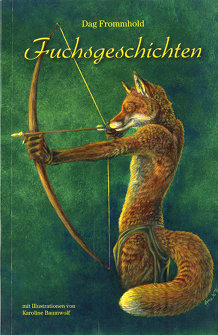 I recently had an article, “The Furry Novel That Nobody Has Read”, published in Anthro #32, November-December 2011. It is about the Dutch About Reynard the Fox (Van de vos Reynarde), by Robert van Genechten, published in 1941. The reason that I had not read it is that it was only published in Dutch, which I do not read. (Yes, I once had a copy.) The reason I said that nobody else has read it is that it is a very anti-Semitic pro-Nazi talking-animal satire that equates rhinoceroses with Jews. There was never an English-language edition, and due to modern anti-Hate literature laws in America and most Western European nations, it could not be reprinted or translated today. (Correction: at least one modern Dutch neo-Nazi group is trying to keep the 1941 Dutch edition available.)
I recently had an article, “The Furry Novel That Nobody Has Read”, published in Anthro #32, November-December 2011. It is about the Dutch About Reynard the Fox (Van de vos Reynarde), by Robert van Genechten, published in 1941. The reason that I had not read it is that it was only published in Dutch, which I do not read. (Yes, I once had a copy.) The reason I said that nobody else has read it is that it is a very anti-Semitic pro-Nazi talking-animal satire that equates rhinoceroses with Jews. There was never an English-language edition, and due to modern anti-Hate literature laws in America and most Western European nations, it could not be reprinted or translated today. (Correction: at least one modern Dutch neo-Nazi group is trying to keep the 1941 Dutch edition available.)
But what about other, modern Furry novels in foreign languages that have never had English-language translations? They certainly exist, and Furry fans in France, Germany and other nations can read them in their own countries; and they theoretically could be translated into English some day. What have we English-language readers been missing?
Dutch – French – German – Indonesian – Japanese – Russian – Spanish – Swedish – Other English
Dutch 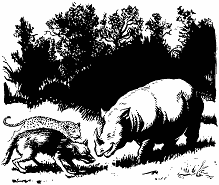
Even though this was the subject of my previous article, for the record I will include it here again. About Reynard the Fox, by Robert van Genechten, was a pro-Nazi modern sequel to the Medieval Reynard the Fox tale, intended as a New Literature for the New Order. A wandering tribe of rhinoceros merchants (blatant caricatures of Jews) come to the Animal Kingdom and try to surreptitiously take it over. Reynard the fox leads the heroic National Socialist common animals in unmasking and killing the rhinoceroses. Van Genechten was an influential official in the Dutch collaborationist government that the Germans installed in 1940, and he used his influence to get About Reynard the Fox published. It was withdrawn from sale as soon as the Netherlands were liberated in May 1945, and has been unavailable since then (unless you have Dutch neo-Nazi contacts).
Anton Koolhaas (1912-1992) is a famous name in modern Dutch literature. Of interest to Furry fans is that he wrote almost sixty short stories featuring anthropomorphized animals; modern animal fables with the animals standing in for human folly. He emphasizes the body as an impediment to the mind, with a constant battle against a paralyzing and distorting loneliness. Two of his best-known stories feature the pig Mr. Tip and the gull Tractaal. However, his animal stories are mostly scattered among his other works.
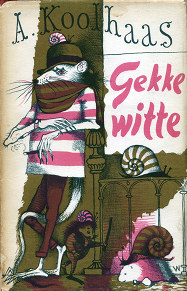
Koolhaas’ only concentrated animal-story volume is Crazy White, and Other Animal Stories (Gekke witte, en andere dierenverhalen), a longstanding school favorite, voted 26th on a list of the 50 Greatest Dutch Books. This is a 1959 collection of four stories; “The Great Stitching”, with the pike Wampoei; “Crazy White”, with the gray mouse Kruuk;
A lengthy description of “Crazy White”, for classroom discussion, is:
Kruuk, a common gray mouse, sees a white mouse sitting in the vault. He goes to 'his' paper basket in the office. He is very confused by his discovery of the white mouse. He imagines that perhaps there are ten thousand white mice, and tells this to the foreman Frot. When he returns to the basement, Frot immediately takes action. Kruuk is not involved because Frot dismissed his concern. Frot goes to the other gray mice and brings to them the story of the ten thousand white mice. Kruuk, however, is obsessed with staring at the white mouse, who in his eyes carries a strange aura of ‘greatness'. He also goes into the vault, but is driven by hunger and cold to return to the floor. The white mouse belongs in a glass bowl, but has been driven out by his neuroses. He is "an outcast and a fool" who clings to the vault, for fear of being chased. The gray mice are particularly worried about the thousands of white mice that they do not see. After some time, the white mouse lies dead on the floor. Krook goes crazy and hides in his wastebasket. If it is emptied he hides amidst the rubbish, until he also dies.
Kees van Toorn, the publisher of the Dutch s-f magazine Orbit from 1977 to 1987, and the Chairman of the 1990 World Science Fiction Convention in the Hague – i.e., an expert in Dutch s-f & fantasy – asks if Harman Nielsen’s trilogy, The Hidden People (Het verscholen volk), counts as Furry? It features humans and Furry aliens, but it focuses on the humans who have been enslaved by the aliens. Hmmm, I’ll take his word for it that the conquering aliens are sufficiently Furry. That is the plot of Pandora’s Planet, by Christopher Anvil (Doubleday & Co., May 1972, 233 p.), in which Earth is conquered by the leonine Centra galactic empire, and that is considered Furry; but that humorous story’s focus is on the sympathetic Centrans with their tawny fur and their lashing tails.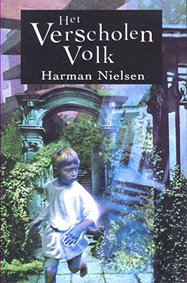
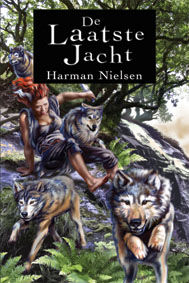
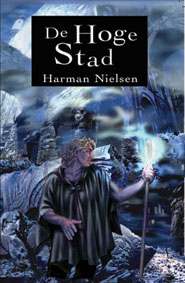
In Nielsen’s first novel, The Hidden People,
The people of Earth are taken away in the slave ships of the K’zan. Only the smallest and most vulnerable are left, driven out of the cities to wander the plains and the rivers. Survival has become not of the strongest, but of the weakest ... Kauw had wondered about the woman. He saw that she remained in the shadows and alleys of the city, avoiding the streets. Her people avoided squares; open space seemed to them a source of fear. They collected their food in slums and cellars: fungi, roots, grasses and small animals who sought their own food. They lived in twilight. But she lived. And they had light. When the second night had fallen, he marveled at the light that radiated from their cellars. Not until the dawn of the next day did he see its source: a child slipped through a door, and disappeared into an alley, with a blue flame trembling in his hand. What powers did this small, hidden people have? How did they survive? By keeping unnoticed by the K'zan remaining on Earth. But now, after three centuries, they must choose between their own lives and the frail, quiet, others that they have saved for so long. The Hidden People, a compelling thriller, combines fantasy and legend in beautifully expressive language. Harman Nielsen has created a magical world full of speed and action into which the reader is irresistibly sucked. (translated publisher’s synopsis)
In the second novel, The Last Hunt,
If most humans have been carried off in the slave ships of the K‘zan, those remaining are especially vulnerable. For them the goal is survival of the weakest, not the strongest – if seen, they are beaten to death by the K’zan guards. After three centuries, their guards have now grown old, and near their end. But one of them refuses to accept her fate. She calls for the return of the K’zan to Earth, risking certain death for the remainder of humanity. Kauw leads the final exodus from the city, accompanied by Bles, the caravan girl; Sparrow, the young Speaker; and Grit, a tiny woman from the Basement People. How their trip went was told in The Hidden People, the first book in the great cycle of novels. But twelve years later, Kauw’s group face unexpected consequences. An almost forgotten risk takes new forms. And he, Sparrow, and the others gather desperately for The Last Hunt.
In the conclusion, The High City,
Again, twelve years have passed. Dusk has fallen on the world of the hidden people. Some are too old now and seek shelter in one of the ruined cities that they once avoided. Past victories seem to lead to defeat, but despite old hatreds, indications are that Sparrow and her children must lead the peoples of the plains and rivers. In fading light, they face enemies they did not know, while their father leads their hunts away into the dark ...
Van Toorn says that in addition to Harman Nielsen’s novels, there are many Dutch or Flemish funny-animal comic strips & books, especially the collections of the beloved Tom Puss (Tom Poes) newspaper strip by Marten Toonder. Funny-animal comics are outside the scope of this article; besides, there is plenty of information on the Internet in English about Tom Puss and Toonder’s other newspaper comics, for those who are interested. I recommend the Looniverse; van Toorn recommends NRC Lux (in Dutch).
Van Genechten, Robert. Van den vos Reynaerde. Illustrated by Maarten Meuldijk. De Amsterdamsche Keurkamer, March 1941, 98 pages.
Koolhaas, A. Gekke witte, en andere dierenverhalen. G.A. van Oorschot, December 1959, 138 p. Contains Het grote stikken; Gekke witte; Een mannetje in de kop; and De vis Zonder Mia.
Nielsen, Harman. Het Verscholen Volk: Fantasyroman. Illustrated by Maurice Hof. In de Keepscheer, November 2003, 251 pages.
Nielsen, Harman. De Laatste Jacht: Fantasyroman. Illustrated by Maurice Hof. In de Keepscheer, November 2004, 343 pages.
Nielsen, Harman. De Hoge Stad: Fantasyroman. Illustrated by Maurice Hof. In de Keepscheer, February 2006, 439 pages.
French
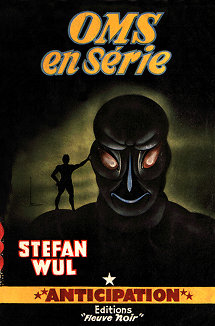 There have been enough French novels with anthropomorphic or semi-human animals published in English over the years -- for two examples, The Rumour in the Forest, by Madeleine Couppey. Translated by Marguerite Waldman. Collins, March 1947, 144 p. (four domestic animal friends, Siko the cat, Rahu the dog, Grey-Flight the pigeon, and Muc the rabbit, try – unsuccessfully -- to escape from humans to live in feral freedom); and Pig Tales, a Novel of Lust and Transformations, by Marie Darrieussecq. Translated by Linda Coverdale. The New Press, May 1997, 151 p.; reviewed in Yarf! #49, July 1997 (all humans slowly metamorphose into animals and struggle to retain their humanity with their new animal instincts; lots of interspecies sex ensues) -- that I feel certain that there must be many others that have never been translated.
There have been enough French novels with anthropomorphic or semi-human animals published in English over the years -- for two examples, The Rumour in the Forest, by Madeleine Couppey. Translated by Marguerite Waldman. Collins, March 1947, 144 p. (four domestic animal friends, Siko the cat, Rahu the dog, Grey-Flight the pigeon, and Muc the rabbit, try – unsuccessfully -- to escape from humans to live in feral freedom); and Pig Tales, a Novel of Lust and Transformations, by Marie Darrieussecq. Translated by Linda Coverdale. The New Press, May 1997, 151 p.; reviewed in Yarf! #49, July 1997 (all humans slowly metamorphose into animals and struggle to retain their humanity with their new animal instincts; lots of interspecies sex ensues) -- that I feel certain that there must be many others that have never been translated.
(Darrieussecq is also the author of Zoo: Short Stories. Editions P.O.L., March 2006, 250 p.; fifteen bizarre short stories – in one, women do not have periods but slough their skins like snakes once a month – but from the synopsis, only a minority feature anthropomorphized animals or humans with animal characteristics.)
To cite a more impressive example, although one that really stretches the definition because humans play the role of oppressed Furries, the French s-f novel – Oms en série, by Stefan Wul, Editions Fleuve Noir, 4ème trimestre 1957, 187 pages -- which was adapted into the 1973 award-winning animated movie Fantastic Planet by René Laloux, was not published in English until November 2010 (as Fantastic Planet, by Creation Books), over fifty years later! So there is hope that the untranslated novels below may yet see an English-language edition some day.
In 1991 Bernard Werber wrote a science-fiction novel, Les Fourmis; le livre du contact, about intelligent ants that try to conquer the world (Ed. Albin Michel, March 1991, 351 p.) It was translated into English by Margaret Rocques as Empire of the Ants in 1996 (Bantam UK, March 1996, 275 p., also reviewed in Yarf! #49, July 1997; American edition in February 1999). But it was only the first book of a trilogy. Its two sequels, The Day of the Ants and The Revolution of the Ants, have never been published in English; nor has been the single-volume collection, The Trilogy of the Ants.
Many American and German detective-cat murder mysteries have been translated into French, but the French do not seem to have any original books in this field. It is the rare publisher who can resist the cat = chat pun in their translated titles, such as “chatastrophe”, though.
There are also very many French funny-animal comic books (or Franco-Belgian; for some reason, the majority of French-language funny-animal comics 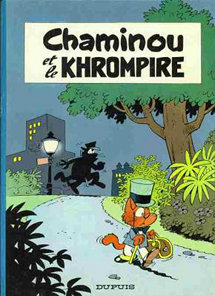 seem to be by Belgian cartoonists and published simultaneously in the French-speaking part of Belgium with a Dutch/Flemish edition) – far more than French adult novels with anthropomorphic animals.
seem to be by Belgian cartoonists and published simultaneously in the French-speaking part of Belgium with a Dutch/Flemish edition) – far more than French adult novels with anthropomorphic animals.
Werber, Bernard. Le Jour des Fourmis; le livre de la confrontation. Ed. Albin Michel, November 1992, 463 pages.
Werber, Bernard. La Révolution des Fourmis; le livre de la compréhension. Ed. Albin Michel, May 1996, 533 pages.
Werber, Bernard. Le Trilogie des Fourmis. Le Livre de Poche, January 2004, 1,393 pages.
German
For an equally unknown reason, Germany has reversed the children’s funny-animal/adult anthropomorphic animal comic-book trend. Aside from Rolf Kauka’s mega-popular Fix und Foxi comics, all of Germany’s funny animal comics are translations or adaptations of foreign comic books. It is in the area of adult novels that original German anthropomorphized animals proliferate.
Murder mysteries featuring intelligent cat detectives have long been popular in Germany*. As long ago as 1819, E. T. A. Hoffman wrote The Life and Opinions of the Tomcat Murr, the autobiography of Murr, a cat. Among many other feline activities, Murr comments on the murder of his friend Muzius. But Murr has been published in English (Penguin Classics, 1999).
In 1988 in America, Christopher Reed wrote The Big Scratch; a Manx McCatty Adventure, a satirical gritty PI murder mystery featuring cats (Ballantine Books). A second McCatty adventure, The Curse of the White Cat [Der Fluch der weißen Katze], was announced, but it was never published in America. A German edition of The Big Scratch was published as Die Katzen Gang in 1995, and the sequel was published there in 1996 as The Curse of the White Cat; A Hard-Boiled Cat Detective Story.
In 1989 Akif Pirinçci wrote Felidae - the Cat Detective Story, a grisly murder mystery set among housecats (Wilhelm Goldmann Verlag, January 1989, 287 p.). It has been popular enough that Pirinçci has written seven sequels to date, and Felidae was made into an animated cartoon feature in November 1994†. But only Felidae (translated by Ralph Noble) and its first sequel, Francis. Roman – Felidae II, as Felidae On the Road (translated by Anthea Bell; Kindle - now down), have been published in English.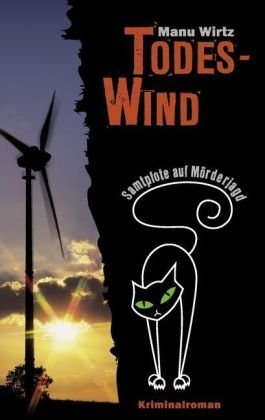
In the last three or four years there has been a flood of animal-detective murder mysteries. Death-Wind: The Feline Friend Who Hunts Killers, by Manu Wirtz, was published in January 2010 and is in its fourth printing already. It could serve as a textbook example of what a “basic” cat murder mystery should be like.
Julie is a typical cat of the Eifel, born on a farm and living with Marieke and Jonas in Bolsdorf. At lunch she overhears a conversation between her humans about a puzzling murder case in neighboring Walsdorf. A human friend of Julie, the man who raised her as a kitten, has just been brutally killed. Julie decides to investigate the crime herself and roams back to Walsdorf. She comes back to her birthplace and meets her many relatives. There, she learns more details. A suspicious farmer took over the victim’s farm many years ago in a swap of arable land. He leased the land a little later to profitable wind energy operators. The farmer felt tricked by the land swap and was furious. There was a public dispute between the two. The suspect made himself suspicious, because he accepted a bribe from the wind power operators and ensured that their applications would be approved easily. There are plenty of clues for Julie to investigate. She secretly enters houses, searching for trespassers and evidence. She also accepts the help of relatives and other interested parties with velvet paws. She uses her sharp mind and her cat intelligence. She manages to place key evidence so that the investigating police and the crowd of people who need it almost ‘stumble upon’ it. At the crime scene itself she makes a sensational discovery that brings them to track down the killer. At the end she makes a major contribution to the exposure of a corruption scandal, as well as to solving the murder. Even if others reap the laurels, she is the real detective. (translated publisher’s synopsis)
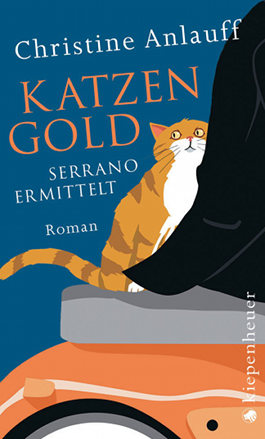 In Fool’s Gold: Serrano Investigates, by Christine Anlauff,
In Fool’s Gold: Serrano Investigates, by Christine Anlauff,
[…] the cat Serrano and Commissioner Liebermann of Sans Souci Palace determine on their own paw to track down the lost hearts of their ladies. Soon they realize that they can only solve the cases together. A warm, funny and very exciting thriller in the shade of the royal parks and walls of Potsdam. Serrano, the proudest tom in Potsdam, quarrels with his friend Aurelia. She wants to mate with him, but he has just been neutered. The next day, Aurelia is swallowed by the earth. At the same time, Inspector Hendrik Liebermann falls in love with a beautiful stranger who has drifted to the gates of Sans Souci. Two sets, a smile, and it happens to him. The next time, he meets the smile on a missing person report: Charlotte Olbinghaus, journalist, has disappeared without a trace. Both Lieberman and Serrano sniff in all corners of their very suspiciously friendly neighborhood. When they find a corpse, they know the murderer's trail leads to both crimes. Christine Anlauff, a resident of Potsdam, received the "German Cats Crime Prize", which was awarded in 2010 for the first time, for this title. A case for two: Christine Anlauff tells of a new investigative duo.
This is also described as the first book in a series about Serrano and Commissioner Liebermann. (Note the pun in the title: Katzengold, or Fool’s gold, and Katzen, cats.)
The second, Cats’ Moon: The Cat Serrano Investigates (Katzenmond: Kater Serrano Ermittelt) was published in August 2012.
In all cases, hangovers and women only bring trouble. While hung over, Serrano agrees to search for his ex-lover Maja’s clumsy daughter. The bumbling Commissioner Liebermann simply cannot believe how much trouble his girlfriend Nico can get into. A headless corpse turns up, and despite a pathologist providing him with plenty of information, Liebermann feels completely at sea. Meanwhile, Serrano is on the bloody trail of an eerie shadow who has attacked three female Persian cats in the neighborhood. Perhaps the old babbler is behind it. His brutal hangover makes it hard for him to prepare for the final battle. Serrano is in demand to restore order in the district. But to succeed, he must work together with Liebermann.
And still they come! Andrea Schacht has burst onto the scene with, not murder mysteries, but a plethora of intelligent cat romances in the last few years. And they all sound just too, too cutesy. The Witch Cat: A Novel, presents
The magic of four paws. Deba McMillen has finally separated from her husband, to build her fourteen-year-old daughter Micki a new life. This includes owning their own house. As soon as they have established themselves, a pregnant cat crosses their path, who decides to have her kittens in their home. But then Deba suddenly discovers that the cat has mysterious powers. Andrea writes the most beautiful cat bestsellers. (translated publisher’s synopsis)
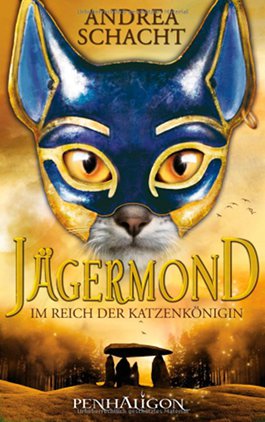 In Hunters Moon - In the Realm of the Cat Queen: A Novel,
In Hunters Moon - In the Realm of the Cat Queen: A Novel,
Bastet Merit, the queen of the cat kingdom of Trefélin, visits our world to say farewell to her dying human friend Gesa. But a catastrophe occurs. Bastet loses her magic ankh, and is not only trapped in our world, but also in the body of a defenseless cat. Her only chance is an earring, which she once gave to Gesa, which has the same capabilities as the ankh. But Gesa has given the talisman to her granddaughter Feli - and not prepared the young woman for her heritage. Feli has no idea what to expect when three fairly inexperienced males in human form suddenly show up, looking for their queen. Finn, the brother of Feli’s best friend, is also implicated in the affair. And besides, he is still in love with her! As if Feli did not have enough problems of her own...
In Christmas Cats,
Cats love Christmas. There can only be Christmas with cats! What happens if a shooting star transforms into a magical cat? Or if a slightly overweight drunkard and an angel join forces? Andrea Schacht tells the story of the secret connection between man and cat and of miracles, that suddenly come true. Two wonderful, highly amusing cat tales, “The Heavenly Christmas Cat” and “The Cat and the Christmas Angel” -- the best of Andrea Schacht.
In her Two Cats Under the Christmas Tree,
Christmas is the celebration of love – and cats. Mauler, a respected street cat, brings Kris, his new master, the meaning of Christmas. Plush and Plunder are antique shop cats, who keep Christmas even under the biggest stress. Christmas with Plush and Plunder - Ginger, a young redheaded woman, inherits an antique shop from her godmother - and a lot of problems. But luckily she has her cats Plush and Plunder to keep Christmas from becoming too stressful. Shortly before the holiday another man appears in the store, who finds more than just the two gorgeous cats. Christmas cats and marshmallows - When Kris gets involved just before Christmas, the young man suddenly has a problem: when Mauler, a brawling street cat, is hurt, he has to care for the animal. What is Kris to do with a cat? But soon he realizes that the brawler is no ordinary cat.
In Schacht’s The Flying Christmas Hangover,
As Christmas approaches, Shardul does nothing better than to dream of flying. But the carpet – rolled up, in which the large-eared tiger cat came from India in an aircraft’s belly to Germany, just does not rise into the air. Shortly before Christmas comes Shardul’s big moment: When his wife Amita’s person, a pilot for a major airline, gets into serious trouble, he recognizes his magical abilities - and that carpets can fly after all. And, by the way, he can help Amita in amorous ways. A magical love story - the new Christmas bestseller by Andrea Schacht.
Another punny title: Weihnachtskater = Christmas cat/drunkard.
Whew! I can’t stand any more, even if this is supposed to be a complete list. Andrea Schacht has also written The Cat With the Golden Eyes; The Cats Will Be Who Brings Tomorrow; Five Cats Under the Christmas Tree (two weren’t enough? This one presents five different cats through the ages from Roman times to today), The Listener in the Confessional: A Cloistered Cat Monastery – A Novel; Looking for the Christmas Cat; MacTiger – A Highlander On Velvet Paws; Mittens: A Cat at Sea; The Twin Christmas Cats; and three about a cat named Tiger (The Day With Tiger, Tiger’s Journey: A Novel, and Tiger On the Track – from the covers, the artists can’t agree on what breed of cat Tiger is); and more! These may not all feature anthropomorphized cats, but I don’t care enough to find out. Her latest is The Hunter’s Ring. A Novel. (April 2012). Katherina Leyden considers herself a realistic young woman who does not believe in the supernatural, until the evening when a talking cat visits her …
Eva Berberich is another author whose many novels are heavily felinized. I can’t tell how many of them are mysteries with anthropomorphized cats, but All for the Cat (November 2001) features a talking cat named Mephistopheles, and A Four-Pawed Heavenly Event: A Christmas Cat Crime (October 2011), has a cat who “dreams of winning a writing contest. With stunning feline charm and blackmail, he persuades his owner to transcribe and submit his imaginative story …”
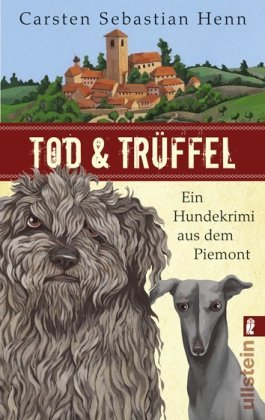
*Where there are cats, can dogs be far behind? Death & Truffles: A Dog Detective Story of the Piedmont, by Carsten Sebastian Henn, features Giacomo, a dog detective who is a gourmet (and wine-lover) and a truffle connoisseur. One reviewer synopsized,
One morning the sleepy village of Rimella is deserted. On the tables, the dishes still stand; in the gardens, washing still hangs. As the wind chimes tinkle, the dog Niccolò desperately searches for his people. Only the experienced truffle dog Giacomo helps him investigate the accident - and work together to prevent one even greater. A deadly adventure begins for the two.
That reviewer went on to praise the novel, but she was in the minority. The majority of reviewers complained that the plot was confused and the depiction of animals (“Die Geschichte um Hunde, Wölfe, Bären, Marder, Krähen und Hasen …”), especially the friendly wild wolf pack, was too unrealistic.
That did not stop the author & publisher from releasing a sequel the next year, Blood & Barolo: A Dog Detective Story of the Piedmont.
For centuries, Pharaohs’ Hounds [the national dog of Malta] have stood guard in front of the Shroud of Turin in the Duomo di San Giovanni station; an honorable task. The inexperienced Amadeus has only just begun his service when the Shroud is stolen. Now he is disowned by his proud family. Fortunately, both the lovable sniffer Niccolò and Giacomo, the perpetrator of tricks to come, come to help him. Giacomo is resigned to his old age, even though he still likes his Barolo [a Piedmontese red wine], but his excellent nose is still reliable. In the castle park of Stupinigi they find the legendary Shroud. But who is behind the robbery? For the clever four-legged friends, a wild chase begins.
These seem to be Henn’s only Hundekrimini. Since then he has continued writing kulinarischer Kriminalroman, but featuring human detectives.
In Willi of Bellden - Who Diggeth a Pit…,: A Dog Detective Story, by Dori Jones,
In a sleepy village in the Hunsrück, where dogs and cats say good night, and little exciting happens, a mutilated corpse is found. The face of the dead man has been removed and replaced by a comic police officer’s mask. Willi, a zippy Terrier, and his mistress, an archaeologist with a heartache, trip during a walk over the police case, and get involved in the investigation. An ancient artifact and the scent of a foreign dog puts them on the track of the murderer. As more people die, all colleagues of Willi’s lord and master, he smelleth a perfidious conspiracy in the otherwise tranquil world of Saarland archeology. Willi must now decide to act on its own, since he sees a threat to the life of his family.
Und natürlich, the recent American mysteries with talking (to the reader) dog detectives have been translated into German (which are noted here just to emphasize how popular animal-detective novels are in Germany). The first two of J. F. Englert’s Bull Moose Dog Run Mystery series about Randolph, the black Labrador with “a nose for murder”, A Dog About Town and A Dog Among Diplomats (Bantam Dell, 2007 and 2008), have become The Sniffer: A Dog Detective Story (2009), and Callous - A Case for the Sniffer: A Dog Detective Story (2010). The third, A Dog at Sea: A Bull Moose Dog Run Mystery (2009), will likely be translated next. (All three have already been translated into Italian.) The first of the New-York-Times-Bestselling Chet & Bernie series, by Spencer Quinn (Atria Books) -- Dog On It (2008), Thereby Hangs a Tail (2010), To Fetch a Thief (2010), and The Dog Who Knew Too Much (2011) -- has become the 2009 hardcover Bernie & Chet: The Trail of the Missing Girl: A Dog Detective Story; the 2011 paperback retitled simply Bernie & Chet: A Dog Detective Story (2011). (This has also been translated into multiple languages.)
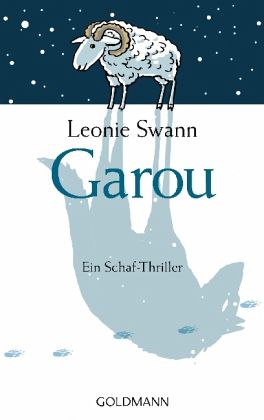
*Also talking sheep detectives; Glennkill. A Sheep Detective Story, by Leonie Swann (Munich, Wilhelm Goldmann Verlag, August 2005), published in English as Three Bags Full: A Sheep Detective Story, by Leonie Swann. Translated by Anthea Bell. (London, Doubleday, June 2006); reviewed in Anthro #13, September-October 2007. Swann has just written its sequel, Garou [Werewolf‡]. A Sheep Thriller, which has not been published in English yet; but a British edition will probably come out next year or so.
The Bleatings continue: a new case for Miss Maple and Co. It is the start of a new, irresistible adventure for the sheep of Three Bags Full. Together with their shepherdess Rebecca they leave their Irish home and take up their long-awaited trip! In France they settle into winter quarters in the shadow of a remote castle, and in fact it could get pretty comfortable - were it not for the goats on the Nachbarweide, the mysterious warning of an alien sheep, and the general unease before the snow. A man in the Wolfspelz! - WHISPERING goats and people. A werewolf! A Loup garou! Or is it only a figment of our imagination? When a corpse is found in the forest, it quickly becomes unclear who is more dangerous: the garou or its hunters. It is clear that the sheep quickly must bring light into the darkness, in order to protect themselves and their shepherdess. And you will soon follow with proven sheeply logic a track that leads you first through the corridors of the castle and the snow flurries of forests … (publisher’s synopsis)
‡ Actually, “Garou” means “Fearsome Supernatural Monster” or “Shapeshifter”. It is an archaic, Middle French word that exists today only in the French “loup-garou” or “wolf-shapeshifter”, for “werewolf”.
*Or pigs. The Ne’er-Do-Wells: A Pig Detective Story, by Arne Blum in 2010, introduced Kim, a carefree domestic pig living on the farm of Robert, a celebrated painter. Kim is shocked when Robert is murdered in her barn, dying after giving her the clue “clover”. When the police suspect Robert’s girlfriend Dörthe, Kim and her own lover, the wild boar Lunke, must investigate to find the real killer. “Kim has been spending the days making beautiful eyes with the audacious Lunke. But now she must follow her nose - and this one digs up very human dregs of greed, blackmail and murder ...” “Crime is good piggy fun - cheeky, charming and entertaining,” said one reviewer.
Blum followed it up a year later with Limelight: A Pig Detective Story.
If people do dirty tricks, pigs have nothing to laugh about! - A new case for the ne’er-do-wells. Domestic pig Kim and wild boar Lunke are back - and become involved in a criminal case to which a note in a wine-collar leads... A drug courier is murdered, a photographer with a hot air balloon crashes, and a killer kills a pig. Now even the pigs get involved! Dörthe Miller saved the pigs from the slaughterhouse and gave them a home. But the animals have no quiet life on the farm: They are too close when two murders are committed, and the killers do not stop from taking animals’ lives. A bloody extortion costs a swan's life, after which they can only believe that it’s one of the pigs’ turn. Now the trough is full to overflowing: the smart house pig Kim calls the boar Lunke for help, and together they create an absolute porcine style of detection ...
Blum’s third adventure with Kim & Lunke, A Beautiful Mess: A Pig Detective Story, was just published in June 2012.
Kim and her lover Lunke, the wild boar, witness a murder. The two swine cannot tell the humans, which frustrates them terribly. The victim was their swineherd, and their trough will remain empty until the humans solve the crime. To make matters worse, a bitter rival of Lunke shows up, just in time to add to the confusion. There is a fiery showdown between humans and pigs, which leads to a beautiful mess …
*Or geese. Approaching Death: A Goose Detective Story, by Karin Bergrath, quickly hopped onto the animal-detective bandwagon.
When the heron Neptune is found at dawn with a gaping beak and a large hole in his chest, it's the end of the idyll at the campsite. The camper Alex finds the body a little later, and fear spreads. Of course, Commissioner Reiners gropes in the dark, and there is only one who can take the matter in hand: Tom Gander. Tom is a CSI fan and his idol is Thomas Magnum. Together with his assistant, Rio, the cormorant, Tom must solve a tricky case, and both risk their lives to help the wingless Commissioner.
Bergrath’s second “Tom Gander thriller”, Murder in Low-Level Flight: A Goose Detective Story, was published in August 2012.
Death comes on silent wings. … A corpse lies in the reeds. When Tom Gander sees the crime scene, he immediately realizes that the wingless Commissioners Hump and Reiners will once more turn a simple murder into a complicated case. The caper can only be solved by the feathered investigators Tom Gander, Rio the cormorant, and Vectra, the young lady cockatoo who not only talks but then unpacks …
*Or insects. For the record, British author Paul Shipton’s Bug Muldoon satirical children’s insect-detective series has been translated into German; at first as juvenile novels but also now repackaged as adult mysteries; e.g. The Bug: An Insect Detective Story (Fischer, November 2000; now up to its tenth printing).
*There are a slew of Horse Detective Stories, but as far as I can tell, they all feature normal dumb horses whose amateur-detective human riders do all the sleuthing.
Finally, animals in general. Mysteries With Fur and Snouts: An Anthology of Exciting Animal Mysteries, edited by Manu Wirtz, presents short stories featuring beasts from throughout the animal kingdom.
They crawl stealthily onto the crime scene. Their beady eyes behold the horror of the sky. With sensitive noses, they smell the fear and anger of the perpetrator. Their skin is hairy, scaly, bristly, feathery or glossy. In the minds of animals, thoughts turn to hunger, vengeance, justice, and murder! Eight exciting animal short stories are waiting for you, written by experienced authors and as colorful as a butterfly’s dress. The editor of this animal-detective anthology is Manu Wirtz. The other authors are Anke Höhl-Kayser, Mary Anne Becker, Aistermann Cornelia, Thies Alexa Meyer, Kristine K. Haas, Michael Harry Liedtke and Carsten Koch. With illustrations by Gabriele Merl.
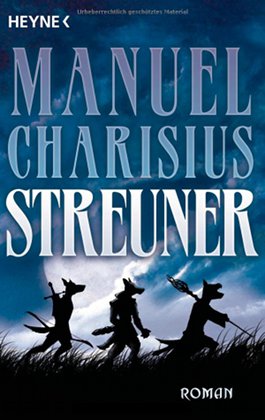 Don’t think that all German Furry novels are animal murder mysteries and romances! Some are science fiction. Streuner, by Manuel Charisius, sounds rather like the Fursuit film Bitter Lake.
Don’t think that all German Furry novels are animal murder mysteries and romances! Some are science fiction. Streuner, by Manuel Charisius, sounds rather like the Fursuit film Bitter Lake.
The Land of the Seven Kingdoms is in chaos: the King of the North has been murdered! For Wolf of the Streuner folk - half human, half animal - this is not a reason for excitement. But as he by chance overhears the conversation of the Conspirators, he recognizes that all seven realms of Lesh-Tanár are in great danger. Together with three other Streuners, Wolf decides to turn the assassins’ craft against them. For the brave Streuner who starts the adventure of your life ... (the publisher again)
The Abolition of the Species, by Dietmar Dath, is set 500 years in the future, when humanity is almost extinct and has been superseded by “the People”, a hybridization of humans and felines ruled by a “Lion”. But war breaks out, the Lion is overthrown, and the People flee into space, where they mutate … The publicity calls this Dath’s Magnum Opus, and compares it to the works of Douglas Adams, George Orwell, and Philip K. Dick. Huh? The reviewers were not kind to it.
Chandri’s World, by Susan Schwartz, is a 2010 reissue of PERRY RHODAN Planetnovel #357 (not to be confused with PERRY RHODAN Universemagazine #357, which is completely different), first published in December 1992. Lesaar, a human with amnesia marooned on the planet Tulsan, befriends Chandri, a Wolfsahnlichen (wolftaur), and gets involved in the politics of the primitive wolftaur natives there.
(Thank Roscoe that Perry’s interstellar Ilt friend Gucky [Pucky in the few PERRY RHODAN novels translated into English], the incredibly cute telepathic-telekinetic-teleporting mouse-beaver, was the last of his species [not counting his son Jumpy]. Otherwise this list might have to include numerous planet-of-the-mouse-beavers novels among the more than 3,500 PR novels published so far.)
There is a German fan-written & self-published collection of four stories, Fox Stories [I suppose that the pun Fox Tales has been overused], by Dag Frommhold, illustrated by his girl friend Karoline Baumwolf, that contains “various anthros, most prominently foxes” in an anthro/human world. The stories are “The Delinquent”, “Wilderness in Chains”, “Checkmate”, and “Night Dust”. Most of the other books in this article merely feature intelligent animals; this one is definitely Furry. It is sold only by the author, and all profits go to wild animal shelters that take care of injured/orphaned fox kits.
Reed, Christopher. Der Fluch der weißen Katze: Ein kerniger Katzenkrimi. Bastei Lübbe Verlag, November 1996, 157 pages.
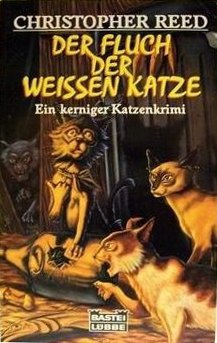 Pirinçci, Akif. Cave Canem. Ein Felidae-Roman. Wilhelm Goldmann Gmbh, August 1999, 285 pages.
Pirinçci, Akif. Cave Canem. Ein Felidae-Roman. Wilhelm Goldmann Gmbh, August 1999, 285 pages.
Pirinçci, Akif. Das Duell. Ein Felidae-Roman. Eichborn Verlag, October 2002, 320 pages.
Pirinçci, Akif. Salve Roma!. Ein Felidae-Roman. Eichborn Verlag, March 2004, 270 pages. (Kindle edition)
Pirinçci, Akif. Schandtat. Ein Felidae-Roman. Diana Verlag, January 2009, 336 pages. (Kindle edition)
Pirinçci, Akif. Felipolis. Ein Felidae-Roman. Diana Verlag, October 2011, 352 pages. (Kindle edition)
Pirinçci, Akif. Göttergleich. Ein Felidae-Roman. Heyne Verlag, September 2012, 352 pages.
Wirtz, Manu. Todes-Wind: Samtpfote auf Mörderjagd. Illustrated by Gabriele Merl. Norderstedt: Books on Demand, January 2010, 156 pages.
Anlauff, Christine. Katzengold: Serrano ermittelt. Roman. Gustav Kiepenheuer, May 2010, 408 pages.
Anlauff, Christine. Katzenmond: Kater Serrano ermittelt. Aufbau Taschenbuch, August 2012, 400 pages.
Schacht, Andrea. Katzenweihnacht. Aufbau Taschenbuch, October 2009, 223 pages.
Schacht, Andrea. Hexenkatze: Roman. Aufbau Taschenbuch, February 2011, 309 pages.
Schacht, Andrea. Jägermond - Im Reich der Katzenkönigin: Roman. Penhaligon Verlag, August 2011, 448 pages.
Schacht, Andrea. Zwei Katzen unterm Weihnachtsbaum. Aufbau Taschenbuch, October 2011, 288 pages.
Schacht, Andrea. Der fliegende Weihnachtskater: Roman. Rütten & Loening, October 2011, 140 pages.
Schacht, Andrea. Der Ring der Jägerin: Roman. Blanvalet Taschenbuch Verlag, April 2012, 448 pages.
Berberich, Eva. Alles fûr den Kater. Deutscher Taschenbuch Verlag, November 2001, 256 pages.
Berberich, Eva. Ein himmlischer Fall für vier Pfoten: Weihnachtlicher Katzenkrimi. Deutscher Taschenbuch Verlag, October 2011, 368 pages.
Henn, Carsten Sebastian. Tod & Trüffel: Ein Hundekrimi aus dem Piemont. Ullstein Taschenbuch, April 2009, 336 pages.
Henn, Carsten Sebastian. Blut & Barolo: Ein Hundekrimi aus dem Piemont. Ullstein Taschenbuch, December 2010, 352 pages.
Jones, Dori. Willi von Bellden - Wer anderen eine Grube gräbt... Stephan Moll, November 2008, 216 pages.
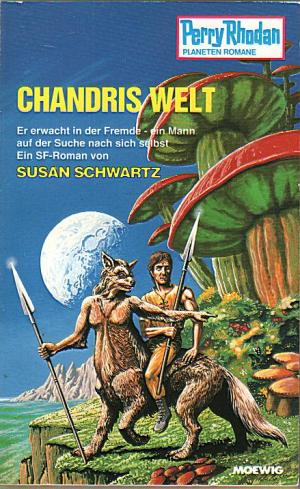
Swann, Leonie. Garou: Ein Schaf-Thriller. Wilhelm Goldmann Verlag, October 2011, 416 pages.
Blum, Arne. Saubande: Ein Schweinekrimi. Limes Verlag, March 2010, 352 pages.
Blum, Arne. Rampensau: Ein Schweinekrimi. Limes Verlag, April 2011, 320 pages.
Blum, Arne. Schöne Sauerei: Ein Schweinekrimi. Limes Verlag, June 2012, 320 pages.
Bergrath, Karin. Tod im Anflug: Ein Gänsekrimi. Scherz, February 2011, 299 pages.
Bergrath, Karin. Mord im Tiefflug: Ein Gänsekrimi. Scherz, August 2012, 352 pages.
Wirtz, Manu, ed. Krimis mit Fell und Schnauze: Eine Anthologie mit spannenden Tierkrimis. Norderstedt: Books on Demand, August 2011, 160 pages.
Charisius, Manuel. Streuner: Roman. Heyne Verlag, July 2010, 576 pages.
Dath, Dietmar. Die Abschaffung der Arten. Suhrkamp Verlag, September 2008, 552 pages.
Schwartz, Susan. Chandris Welt. Verslagsunion Pabel-Moewig, May 2010, 160 pages.
Frommhold, Dag. Fuchsgeschichten. Illustrated by Karoline Baumwolf. Fuechse.info, August 2008, 217 pages. Contains Der Delinquent, Wildnis in Ketten, Schachmatt, and Nachtstaub.
Indian
India has twenty-two official languages, and s-f & fantasy novels going back to the 19th century. However, none of them seem to have Furry characters, despite the animal-headed Hindu gods like Ganesha and Hanuman who do not appear in many original novels anyway. There are active Indian animation and comic-book industries, but this article does not include those fields.
Indonesian (or Malay or Tagalog)
Dr. John A. Lent, an authority on Asiatic communication and popular culture (cinema, comic books, literature, etc.), does not know what privately-published Southeast Asian Furry-fan novels there may be, but he feels sure that there is nothing in mainstream Indonesian, Malay, Tagalog, Thai, etc. s-f/fantasy that contains anthropomorphic or intelligent animals.
The fans on the AnthroAsia forum agree. Hollud says that,
Anthropomorphism is very much a Western concept passed on to this part of the world. When I was growing up, the only exposure to anthropomorphic characters was through children's storybooks or through cartoons on the television. Even the first few books that I did get (Anne McCaffrey's Dragonriders of Pern) was at a local Borders store or through Amazon. Here, in Singapore, where English is the language of instruction, most of our material originates from the West.
and
Even if they were novels written by Asian writers, it was probably most written in English (to target a more globally reaching audience) or done in a form spanning beyond written language (e.g., comics, drawings, manga).

Japanese
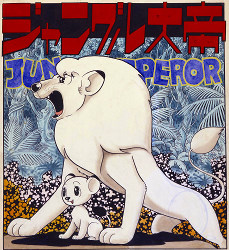 Unfortunately, nobody from Japan answered my query about adult novels with anthropomorphized animals, and I do not know enough Japanese to research this on my own.
Unfortunately, nobody from Japan answered my query about adult novels with anthropomorphized animals, and I do not know enough Japanese to research this on my own.
I do know that there have been many anthropomorphized animals in children’s and adult manga, from Suihō Tagawa’s Norakuro in the 1930s to Osamu Tezuka’s Junguru Taitei in the 1950s and Fujiko F. Fujio’s Doraemon in the 1970s. The greeting-card/gift company Sanrio created its mega-popular merchandising star Hello Kitty (the mouthless one’s name is Kitty White) for little girls in the 1970s, and today there is every kind of juvenile and adult merchandise from erotic vibrators (for those little girls grown up) to a $999 Hello Kitty robot that can be programmed to babysit for busy parents.
A good example of mature manga is Motofumi Kobayashi’s Cat Shit One (or maybe not so good, since it has been translated into English, as Apocalypse Meow), a bloody Vietnam war story with the Americans as rabbits (there is a bilingual pun here, from the Japanese for rabbit, usagi, to “USA G.I.”), the Vietnamese as cats, the French as pigs, the Chinese as pandas, the Japanese as monkeys, the Russians as bears, and so on.
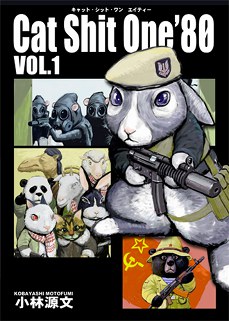 Also, cute anthropomorphized animals are very popular in Japan as sports mascots and corporate logos. With all these, there are quite likely some in adult literature as well.
Also, cute anthropomorphized animals are very popular in Japan as sports mascots and corporate logos. With all these, there are quite likely some in adult literature as well.
Russian
Since this is a study of adult fiction, the juvenile Russian Oz novels of Aleksandr Volkov and their sequels by Yuri Kuznetsov, Leonid Vladimirski, and others are not included. Volkov translated L. Frank Baum’s The Wonderful Wizard of Oz in 1939 (very loosely; for example, Volkov later explained that he described Kansas as a happy, cheerful land because if he translated it accurately as Baum wrote it, as cheerless and gray, everyone would have assumed that he had been ordered to change it into anti-American propaganda; also, he gave Toto an active speaking role). It was so popular that he went on to write five sequels of his own, which are full of talking animals (and some eyebrow-raising socialist aspects such as the Oz People’s Liberation Army in Urfin Joos and His Wooden Soldiers). They were also so popular that after Volkov’s death they were continued by others. Or any of numerous other Russian children’s books with talking animals.
Pavel Shumilov wrote loosely-connected fantasy/s-f stories about intelligent dragons, Dragons’ Tales, online between November 1994 and January 1998. In 1999 they were all published as four books; The Lone Dragon, The Dragon of the Congo Castle, To Become a Dragon, and Caravan of the Dead.
Where did the dragon come from that can fly and not fly, feeds like a man who eats everything, and is practically immortal? Something is just right: take the genius of genetics, throw in a parallel universe, give him the necessary tools, and take ten years of his life. And life on Earth, stuck in the Middle Ages, explodes. The church is suffering defeat after defeat, jousting has replaced expeditions into space, and one lone dragon is the beginning of a whole race of winged wise men. (publisher’s synopsis of The Lone Dragon)
In The Dragon of the Congo Castle, a spaceman and a dragon team up to rescue a damsel in distress on an alien planet. In To Become a Dragon, a man wonders where so many flying dragons suddenly came from. And in Caravan of the Dead … well, the synopsis is all about two men in a womens’ slave market. No dragons are mentioned at all, though there certainly is one on the cover.
Vladimir Vasilèv (or Vasilyev) and Anna Li have co-authored three s-f novels with semi-animal characters:
In Going Into the Night,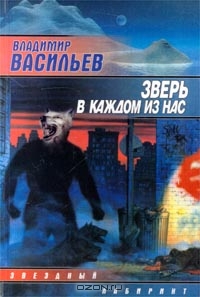
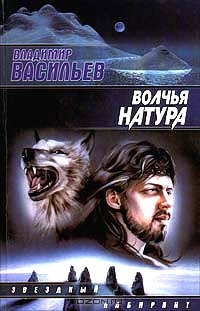
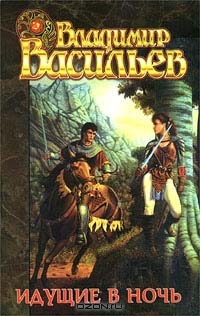
Imagine a world where there is no night, only blue and red days changing from one to the other. And there are lycanthropes who on one day look like humans and on the other day like beasts. The humans remember nothing about the beast time, nor the beasts of the human. Two such outcasts have to go far away to the fabulous U-Narinna, Stone forest. During the red days, a girl with a wolf goes there, while during the blue days it's a man and a big cat. They will meet a lot of adversity and adventure on this way, a way to the Stone Forest and on the way to themselves. (from Vasilèv’s website)
In Lupine Nature and The Beast in All of Us,
The duology «Lupine Nature» and «The Beast in All of Us» is rather like a espionage novel in an unfamiliar entourage. On Earth, where by a strange whim of nature not the primates, but the descendants of cynoids, dogs, became intelligent. The world followed the biological way of development but in the end came to mechanical technologies. The world where people are as diverse as dogs in our world. There are no murders - murderers simply go insane, because several hundred years ago all humanity was genetically modified and stripped of all aggressiveness. And it comes out that in Siberia there are true wolves, predators, for whom killing is as natural as breathing. All the world's special services begin hunting them; events unfold in a way that makes unknown, who will turn out to be a merciless beast - meek humans or predatory wolves.
The two novels were first published separately, then in a combined edition.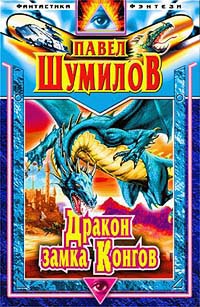
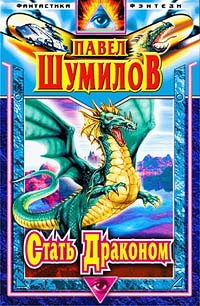
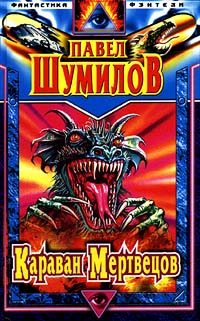
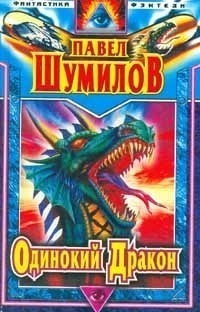
Shumilov, Pavel. The Слово о драконе (Slovo o drakone) series:
Shumilov, Pavel. Одинокий Дракон (Odinokiy Drakon). Centerpolygraf, 1999, 459 pages. Contains The Lone Dragon (Одинокий Дракон) and The Last of the Sovereigns (Последний Повелитель).
Shumilov, Pavel. Дракон замка Конгов (Drakon zamka Kongov), Centerpolygraf, 1999, 508 pages. Contains The Long-Forgotten Planet (Давно забытая планета) and The Dragon of the Congo Castle (Дракон замка Конгов).
Shumilov, Pavel. Стать драконом (Stat’ drakonom). Centerpolygraf, 1999, 491 pages. Contains To Become a Dragon (Стать драконом) and Shards of Eden (Осколки Эдема).
Shumilov, Pavel. Karavan Mertvetsov (Karavan Mertvetsov), Centerpolygraf, 1999, 489 pages. Contains Go and Catch a Falling Star (Иди, поймай свою звезду), Caravan of the Dead (Караван Мертвецов), and Adam and Eve – 2
Vasilèv, Vladimir and Li, Anna. Идущие в ночь (Idushchie v noch), Terra, January 1999, 542 pages.
Vasilèv, Vladimir and Li, Anna. Волчья натура (Volchìa natura), AST, 1999, 384 pages.
Vasilèv, Vladimir and Li, Anna. Зверь в каждом из нас (Zver' v kazhdom iz nas), AST, 2000, 382 pages.
Vasilèv, Vladimir and Li, Anna. Волчья натура (Volchìa natura) / Зверь в каждом из нас (Zver' v kazhdom iz nas), AST, 2005, 606 pages.
South African
Rakuen Growlithe and Umuntu both say that there are no South African Furry novels, in Afrikaans or English. (Umuntu has moved to America and written his own, in English, Chronicles of Solo: Moments Away, formerly available from Lulu Press.)
Spanish
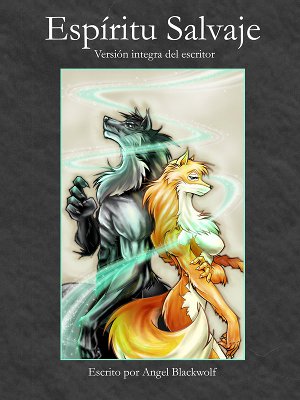 Well, it looks like this article is written just in time to get these 2011 editions – and by a Furry author and artist, Angel Blackwolf and Siekfried [sic.] Schneider. If I'm reading Blackwolf’s deviantART page correctly, he wrote Savage Spirit in 2004, but I can’t find any record that it was published until 2011.
Well, it looks like this article is written just in time to get these 2011 editions – and by a Furry author and artist, Angel Blackwolf and Siekfried [sic.] Schneider. If I'm reading Blackwolf’s deviantART page correctly, he wrote Savage Spirit in 2004, but I can’t find any record that it was published until 2011.
They say that legends are just that, legends. Not to be ignored, because they are stories that are intended to attract attention. But, what if some are not just stories, and before you know it, you're in the midst of reality? Many fight against their own personality, against sanity and common sense. Others, on the contrary, give in to force, and enjoy the trip. In your hands is one of those rare cases where fantasy, reality and dreams are intertwined to such an extent that its protagonist must think and decide, so far.
Blackwolf has also written the two-volume Dragon’s Blood, the first of which is [or was] available in English, in both regular and “special” editions; but the second volume does not seem to be, yet.
The second volume of the adventures of the young werewolf Angel Blackwolf and his companions. The group formed by Angel and company finally prepares to embark on their trip across the length and breadth of the world. All hope to find the necessary answers to all their questions and concerns, although none of them, as you can imagine, realize the magnitude of what they will encounter. The last of their number will return to its rightful place.
The “Special Edition” includes the second chapter of a “parallel” story, “Dragon’s Blood: Alshira”.
I admit to being confused by the different number of pages in the different editions of Dragon’s Blood, No.2, and of Savage Spirit.
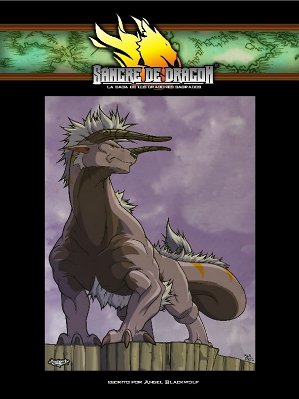 There is a Dragon’s Blood Art Book that reprints Schneider’s small black-&-white illustrations from No. 1 in full pages and in color, plus collaborations with other artists. It is without text and with a title in English, but the Lulu.com catalogue lists it as “in Spanish” so I have included it here. There are two further titles that, from their pagination, are trade paperback and Kindle editions of Furry individual short stories or novelettes, which I am omitting.
There is a Dragon’s Blood Art Book that reprints Schneider’s small black-&-white illustrations from No. 1 in full pages and in color, plus collaborations with other artists. It is without text and with a title in English, but the Lulu.com catalogue lists it as “in Spanish” so I have included it here. There are two further titles that, from their pagination, are trade paperback and Kindle editions of Furry individual short stories or novelettes, which I am omitting.
Blackwolf, Angel. Sangre de Dragón. No. 2. Lulu.com, June 2009, 235 pages.
Blackwolf, Angel. Sangre de Dragón. No. 2. (Regular edition). Lulu.com, April 2011, 328 pages.
Blackwolf, Angel. Sangre de Dragón. No. 2. (U.S. Residents edition) Lulu.com, April 2011, 355 pages.
Blackwolf, Angel. Sangre de Dragón 2 (Edición Especial). Illustrated by Siekfried Schneider. Lulu.com, July 2011, 234 pages (hardcover).
Blackwolf, Angel. Sangre de Dragón 2 (Edición Especial). Illustrated by Siekfried Schneider. Lulu.com, July 2011, 256 pages (trade paperback).
Blackwolf, Angel. Espíritu Salvaje. Illustrated by Siekfried Schneider. Lulu.com, May 2011, 658 pages.
Blackwolf, Angel. Espíritu Salvaje (Versión del Director). Illustrated by Siekfried Schneider. Bubok, May 2011, 803 pages.
Blackwolf, Angel. Espíritu Salvaje (Versión del Director). Illustrated by Siekfried Schneider. Lulu.com, July 2011, 345 pages (trade paperback).
Blackwolf, Angel. Espíritu Salvaje (Versión del Director). Illustrated by Siekfried Schneider. Lulu.com, August 2011, 366 pages (hardcover).
Blackwolf, Angel. Dragon’s Blood Art Book. All art. Lulu.com, August 2011, 46 pages.
Swedish
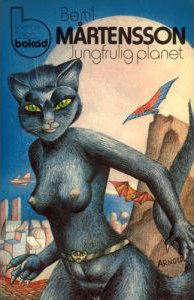 Two novels with Furry characters that have never been translated into English are Virgin Planet and The Golden Leap, both by Bertil Mårtensson. They are very similar to James Cameron’s movie Avatar, as many Swedish fans have noted; about humans coming to the planet Batak (a.k.a. “Catworld”) to mine the rare metal Theor+, and trying to exploit its blue felinoid natives.
Two novels with Furry characters that have never been translated into English are Virgin Planet and The Golden Leap, both by Bertil Mårtensson. They are very similar to James Cameron’s movie Avatar, as many Swedish fans have noted; about humans coming to the planet Batak (a.k.a. “Catworld”) to mine the rare metal Theor+, and trying to exploit its blue felinoid natives.
When the unsuccessful academic Sefrem Ibrahim is offered a job as organic overseer on a world named Batak, the wait to get there is not hard. His thoughts are entirely of the myth of idyllism on a virgin world. He does not even listen to the cautionary words of Vitriolic, the large sexy she-cat of the Catworld. But he is forced against his will to realize that what is happening in fact is a terrible exploitation of a rich world’s resources. Sefrem tries to stop the environmental destruction without realizing the forces that he is up against; influential people who are prepared to continue exploitation until there is nothing left on the planet. Virgin Planet shows once again that Bertil Mårtensson is Sweden's leading SF-author.
The Golden Leap, published ten years later, is actually a prequel telling of the first human settlement of Batak.
Mikael and Jennifer are on their way to planet ZQ9001 for their new life. They are part of a large group of emigrants who are leaving the tired Earth to seek paradise. And ZQ9001 seems to be precisely this paradise. A planet filled with endless forests, far savannas, and above all no people. But ZQ9001 differs from all other planets colonized by man. There is in fact intelligent life, perhaps even more intelligent than human beings. A kind of gigantic cats had lived for thousands of years in total balance with their environment. Their lives concentrated around the hunting requirements of cooperation, and around humility before mathematics or magic. This life is, however, in direct conflict with human selfishness and greed. So how can people and cats ever be able to cooperate on ZQ9001? This is an exciting and readable story of the human first meeting with an extraterrestrial intelligence. Bertil Mårtensson has created a beautiful and light race with feline intelligence. It could be said that cats are all that man should be; humble, cooperative, considerate and intelligent. This tale makes transparent how humankind really is a mixture of both good and bad faith.
Mårtensson, Bertil. Jungfrulig planet: en framtidsroman. Illustrated by Hans Arnold. Bokád Bokförlag AB, 1977, 253 pages.
Mårtensson, Bertil. Det gyllene språnget: roman. Nyblom, 1987, 295 pages.
Other non-English
It is convenient that almost all of these can be ordered from international online booksellers or publishers today, many in e.book editions. But what about books in Chinese, Danish, Greek, Hebrew, Hindi (or India’s 21 other official languages), Italian, Japanese, Portuguese – heck, Armenian? There must be more foreign Furry novels than these that have no English-language editions yet. Does anyone know of any?
Other English 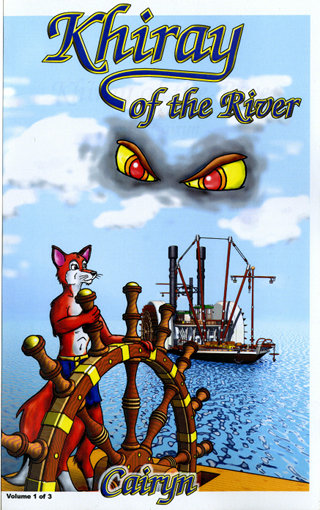
If I had written this article twenty years ago, I would have included English-language books published outside of the U.S.A. Amazon.co.uk started in late 1998 and British books have become well-publicized in America, making it easy to find out about and mail-order British Furry books. But until recently there was no way to get English-language Furry books published in Australia, Canada, Ireland, or New Zealand, like the Canadian Raven's End: A Tale from the Canadian Rockies, by Ben Gadd (Douglas Gibson Book/McClelland & Stewart, February 2001, 347 p.) or the Irish Song of the River, by Soinbhe Lally (Poolbeg/Beacon Books, June 1995, 137 p.), which were unknown in the U.S. and not available through Amazon.co.uk.
During the 1980s to early 2000s, I spent a lot of time tracking these down and trying to mail-order them from their publishers or national bookshops – which usually did not accept American dollars and wanted payment only in their own national currencies. For one example, the Australian Teeth of the Storm, by Rick Wilkinson (Allen & Unwin [Australia], January 2000, [iv +] 208 p.; reviewed in Yarf! #65, July 2002).
Fortunately, today almost all these books have U.S. or British editions – and there is also the addition of Amazon.ca for Canada in 2002; and Amazon.co.uk now includes Irish books -- which can be easily ordered. The first Australian Furry novel, Dot and the Kangaroo, by Ethel C. Pedley, illustrated by F. P. Mahony (published in London; T. Burleigh, November 1899, 109 [+20 art plates] p.), had many Australian editions throughout the 20th century, but did not have an American edition until about ten years ago; but it now has many thanks to electronic and print-on-demand editions of public-domain books. One New Zealand novel does not seem to have been reprinted elsewhere yet, but it probably will be soon since the novel to which it is a sequel, Beak of the Moon (Collins [Auckland], July 1981, 381 p.), advertised as “the bestselling novel of 1981, an instant classic”, was published in Britain in 2008.
Temple, Philip. Dark of the Moon. Penguin Books [Auckland], September 1993, 287 pages.
My thanks to the many international fans and scholars who answered my call for information about Furry novels in their languages; in particular to Dr. John A. Lent and Hollud for negative information about Southeast Asian titles, and Rakuen Growlithe and Umuntu for negative information about South African titles, to Kees van Toorn for helping me to identify Dutch titles, to Cairyn¶ and EosFoxx for helping with German titles, to Aaz, Opka?, and SimBa for helping with Russian titles, to Vicente “skifi” Patiño for helping with Spanish titles, and to Ahrvid Engholm (bio) for helping with Swedish titles; and to Dag Frommhold for sending me a copy of his book (now in a 2010 second printing).
Fox Stories is still available directly from Frommhold. The price for the attractive and illustrated book including shipping to the U.S. is €19,00. Purchasers can pay via Paypal to baumwolf@gmx.de and include the address they would like to have the book shipped to. Alternatively, they can just contact Karoline “Alpha_Ki” Baumwolf or Frommhold via e.mail (shadowfox@foxes.de).
(¶And I am still recommending Cairyn’s long-out-of-print English translation of his Khiray of the River [Storyfur Prime Special, July 2001, 451 pages] as one of the finest Furry novels that I have ever read, and long overdue for a new edition!)
About the author
Fred Patten — read stories — contact (login required)a retired former librarian from North Hollywood, California, interested in general anthropomorphics

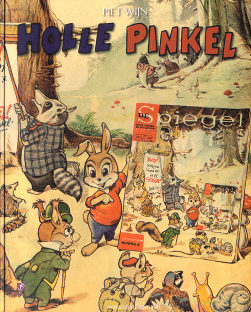

Comments
Wikipedia translates the French s-f novel “Oms en série” by Stefan Wul as “Oms Linked Together”. The title is also frequently translated as “Oms by the Dozen”, which I think captures the spirit of the plot better.
Fred Patten
This is a really good summary of what's out there, especially if someone is looking to expand into other cultures' stories.
While not falling under the category of novels I might still have mentioned there are a number of short stories from the traditional myths of various African tribes. Those have been made into nice collections by Nick Greaves. They have stories mostly focussed around anthropomorphic (at least mentally) animals which explains various things from the natural world. For example a cheetah's claws don't retract because they actually traded paws with a wild dog to win a race against an antelope or that the black stripes on their face are tear stains from when a cheetahs cubs were stolen by man.
"If all mankind minus one, were of one opinion, and only one person were of the contrary opinion, mankind would be no more justified in silencing that one person, than he, if he had the power, would be justified in silencing mankind."
~John Stuart Mill~
I rated this 5 stars. It starts out strong... gets really dry and catalogue-like (I can only skim past the german section,) then gets good again in the summary of "other". Readability aside, it's a lot of rare info.
The opening and Dutch section in particular is almost like something I might read in the book dealer trade journals, or articles about notable collections offered from auction houses... but with fandom not business/history perspective.
The Reynard the Fox book, especially, has many qualities (like connection to world history, notoriety, being banned) that create the kind of coveted rarities that make antiquarian book dealers' bread and butter. (I haven't checked what prices it gets).
The Koolhaas book crosses world lit interest with niche focus and uniqueness among the author's works, making it great grist for this. (I've sold very expensive books about his famous architect son, too.)
A really good scholarly article could be made about this stuff. (Like, aimed outside fandom- a lot of this stuff is surely pretty minor). Especially since there are some relatively whacky-high amounts paid for these items sometimes. (Remember the $1000 pony porn magazine posted here months ago? That would be something to mention for, like, alternative bibliohistory... or some other word, I can't think, it's way too late... there is some serious porn scholarship out there, though.) More "legitimately", check this out.
Here's one of those trade journals I was talking about. Or I wonder if Bookride would have anything to say about anthropomorphic lit?
You appear to have missed one of the most famous "animal as human" works in world literature--the Kalila wa Dimna. It's an Arabic translation of a Persian translation of a Sanskrit original. The title characters are two jackals at the court of the lion king.
I will be mightily surprised if I only missed one book out of the whole world’s non-Engish literature. Thanks for calling this out.
However, this is hardly untranslated. Various sources say that Kalila wa Dimna, a.k.a. Kalila and Dimna, a.k.a. the Panchatantra, has been “a bestseller for almost two thousand years”. (Saudi Aramco World, July-August 1972.) Wikipedia says, “The Latin version was translated into Italian by Antonfrancesco Doni in 1552. This translation became the basis for the first English translation, in 1570: Sir Thomas North translated it into Elizabethan English as The Fables of Bidpai: The Morall Philosophie of Doni (reprinted by Joseph Jacobs, 1888). […] Among modern translations, Arthur W. Ryder 's translation (Ryder 1925), translating prose for prose and verse for rhyming verse, remains popular. In the 1990s two English versions of the Panchatantra were published, Chandra Rajan's translation (based on the Northwestern text) by Penguin (1993), and Patrick Olivelle's translation (based on the Southern text) by Oxford University Press (1997). Olivelle's translation was republished in 2006 by the Clay Sanskrit Library." So this is hardly unknown in English.
Fred Patten
One obstacle to making an article like this readable outside of fandom, is the way it lumps together all kinds of stuff using only country to classify it.
This is surely a well worn subject, but it could use much more defined classification. The article's readability suffers without it.
It's confusing to lump together self published stuff right from fandom, with 1930's and 40's classic lit. "Furry" wasn't a term until the 80's, right?
Anything before that, or parallel but separate could be labeled "anthropomorphic" (which you could loosely break down even more by the way anthropomorphism is used and why.) Ancient world lit, common popular fables, funny animal comics, and talking cat detective novels can be separate (except when they put genres together.)
Anything that influenced the first generation of furries, but before there was a fandom, might be called proto-furry, or something... Watership Down, Fritz the Cat.
Fandom-specific stuff is its own category.
I think I've seen this topic on here before...
My goal was to call attention to anthropomorphic literature in non-English languages that Furry fans might be interested in if they knew about it. I didn't worry about lumping self-published stuff in with commercially-published books, or mixing fiction genres within a language, or classic fiction with the latest fiction.
Fred Patten
For a constructive suggestion, if things weren't so lumped together, that goal could be achieved better (and it could aim wider than fandom). It's one thing to make a list, and another thing to be a guide.
This isn't just me being smartass at a "furry elder statesman". Think of what quality scholarship can do for this fandom. They teach courses on science fiction at universities.
Lots of my opinions are amateur ones, but this one's a bit more than that.
Fan activities are cool too, so carry on. :)
I have to admit that I do not read any of these languages except French, so I would be unable to do much more than just list titles.
Fred Patten
You did more, though... it was great to read all that context you gave about the Reynard the Fox and Koolhaas books. (I had to figure out he was the father of world famous architect Rem Koolhaas by guessing and googling it.)
M. Zobern has sent me an e-mail naming four more Russian s-f stories; three novels and a short work. The Sacred Book of the Werewolf (Священная книга оборотня) and A Werewolf Problem in Central Russia (Проблема верволка в средней полосе) by Victor Pelevin; The Heart of a Dog (Собачье сердце) by Mikhail Bulgakov; and Epic Predator (Эпос хищника) by Leonid Kaganov.
But the first three of these have been published in English: Pelevin’s The Sacred Book of the Werewolf (translated by Andrew Bromfield, Viking, September 2009, 335 pages) and A Werewolf Problem in Central Russia (in Pelevin’s collection A Werewolf in Central Russia and Other Stories, translated by Andrew Bromfield, New Directions Publishing Corp., November 1998, 213 pages); and Bulgakov’s The Heart of a Dog (translated, with an Introduction, by Michael Glenny, Harcourt, Brace & World/A Helen and Kurt Wolff Book, June 1968, ix + 146 p.).
Epic Predator by Leonid Kaganov has not been. But is it published separately? Zobern says, “Not novel, but very furry.” Is it a short story or a novelette? More information is needed.
Fred Patten
I'm guessing it's this Epic Predator? I think it is also available as an audiobook, but perhaps my translation is incorrect.
As for furriness, this character appears to meet the specification.
It certainly sounds like it, though 379 pages does not sound like a short story. Can you find a summary of the plot?
Fred Patten
Oh, I see. This is an anthology of short stories by the author, using that story as the main title.
The story in question has been reprinted several times.
Here is an "abstract" (summary?) of the anthology:
The author has a page about it (translation). The story in question appears to be here (translation). And a review (translation).
A one-line summary:
So the story Epic Predator itself is only 18 pages. And to nitpick, the book is a COLLECTION of Kagan's short stories. An ANTHOLOGY is a book of stories by different authors.
Fred Patten
In terms of Chinese furry novels, I can't say that I'm well read. I can say that there's a popular kid's series called 笑猫日记 (The Smiling Cat Diaries). It involves a cat who goes around doing...various things. The books are all over the place in terms of themes. One of them I read was a story about the main character trying to find this girl cat. The other one I read dealt with the earthquake in Sichuan. I can also say that Pleasant Goat and Big Big Wolf 喜羊羊与灰太狼 is HUGE. I will be compiling a report on this soon when I get some free time.
Well, im Angel Blackwolf the writer, if anyone habe questions about my storys and book, only contact me ;)
Post new comment